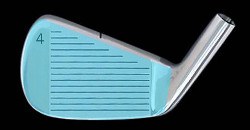
In golf, “club grooves” refer to the indentations or channels on the clubface of irons, wedges, and some fairway woods. These grooves are designed to help golfers generate spin and control the flight of the golf ball when striking it.
Here are a few key points about club grooves:
- Purpose: The primary purpose of club grooves is to increase friction between the clubface and the golf ball, especially in situations where the ball comes into contact with moisture, grass, or other challenging lies. The grooves help to channel away debris and water from the clubface, allowing for cleaner contact and more control over the ball.
- Spin Generation: When the ball strikes the grooves on the clubface, it creates additional friction and spin. This backspin helps the ball grip the playing surface, preventing it from sliding or rolling too much upon landing. The spin also allows golfers to control the trajectory and stopping power of their shots, particularly on approaches into the green or shots from the rough.
- Regulations: The governing bodies of golf, such as the United States Golf Association (USGA) and the R&A, have specific rules regarding club grooves to maintain fairness and skill in the game. These rules dictate the maximum dimensions, shape, and sharpness of the grooves to prevent excessive spin and provide a level playing field for golfers.
- Groove Types: The design and pattern of grooves can vary among clubs and manufacturers. Common groove types include V-grooves, U-grooves, and square grooves. Manufacturers may also incorporate additional groove technologies, such as microgrooves or laser-milled grooves, to enhance spin and control.
- Groove Wear and Maintenance: Over time, the grooves on clubfaces can wear down due to regular use and contact with the ball and the turf. This can result in reduced spin and control. It's important for golfers to regularly inspect their club grooves and consider regrooving or replacing clubs as needed to maintain optimal performance. Additionally, cleaning the grooves after each shot and using a groove brush or tee to keep them free from dirt and debris can help preserve their effectiveness.
Understanding the role of club grooves and their impact on spin and control can aid golfers in making informed shot selections and executing shots more effectively. Golfers can consult with club fitters, golf professionals, or refer to manufacturer specifications to ensure their club grooves comply with regulations and suit their playing style and course conditions.
Lines that are cut, pressed or cast into the golf clubface. Grooves appear on woods, hybrids and irons and are designed to impart backspin by grabbing the surface of the golf ball on contact.
Golf’s rules specify the maximum width (0.035”), depth (0.020”) and spacing (varies with width and depth) of grooves in order to limit the amount of spin clubs can produce, especially from long and/or wet grass. Grooves may be any shape as long as they conform to the above requirements. For example, viewed on a cross-section, some grooves form a V, while others are U-shaped.





